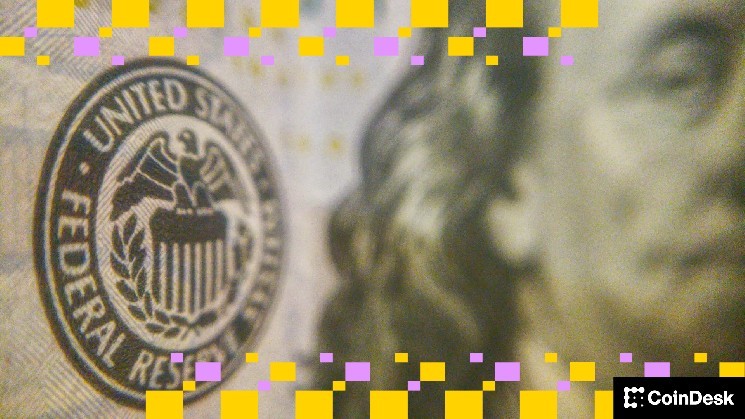
The U.S. Federal Reserve (Fed) pumped $29.4 billion into the banking system on Friday, sparking optimism on crypto social media. While the move aimed at easing liquidity concerns and is supportive of risk assets, including bitcoin, it's nothing out of the ordinary. The Fed pumped billions through overnight repo operations, the largest since the 2020 coronavirus pandemic, to ease liquidity stress that has supposedly capped bitcoin’s BTC$107,971.57 gains in recent weeks. The operation, conducted via the standing repo facility (SRF), temporarily boosted cash available with primary dealers and banks and aimed at adding short-term liquidity into the system, lowering repo rates back toward normal levels, preventing a sudden freeze in short-term funding markets, and giving banks breathing room to manage reserves while the Fed monitors the situation. All this sounds too technical, so let’s break it down to understand how the repo, bank reserves, and the Fed’s latest action are related. The repo The repo, or repurchase agreement, is a short-term loan made overnight between two parties — one with idle cash in a bank deposit who wants to generate yield from it, and the other party looking for a cash loan against valuable collateral, such as U.S. Treasury securities and bills. The two parties agree on an interest rate, and the cash is loaned overnight with the promise to buy back the asset on the following day. The lenders in these transactions are typically large money managers, such as money market funds. Bank reserves The repo deals affect the bank's reserves. As the lender transfers cash to the borrower, the reserves at the lender's bank decrease, while those at the borrower’s bank increase. An individual bank is vulnerable to strain if many of its accounts lend money to borrowers at other banks. Banks need sufficient reserves to meet regulatory requirements and conduct their daily operations, so they may borrow reserves themselves or adjust their balance sheets as required. And when facing a shortage, they tap the repo market or other Fed facilities such as the discount window or the Supplementary Financing Rate (SFR). However, when reserve shortages become severe across the system, it pushes up repo rates as lendable cash becomes scarce, and more borrowers compete for less cash, causing liquidity to tighten. This is where the Fed steps in, and that’s precisely what it did on Oct. 31. The giant liquidity injection through the SRF, a tool put in place to provide fast loans collateralized with Treasury or mortgage bonds, happened as bank reserves slipped to $2.8 trillion, lifting repo rates. Lendable cash had become scarce, reportedly due to the balance sheet runoff, referred to as quantitative tightening (QT), and the Treasury’s decision to bulk up its checking account at the Fed, known as the Treasury General Account (TGA). Both withdrew cash from the system. Putting it all together The repo rates increased as lendable cash became scarce due to the Fed’s QT and Treasury cash buildup. Bank reserves declined below the supposed ample level threshold. The situation caused some stress. That led to the Fed pumping liquidity through the SRF facility How does it affect BTC? The $29 billion liquidity boost effectively counteracts the tightening by temporarily expanding bank reserves, lowering short-term rates, and easing borrowing pressures. The move helps avoid potential liquidity crises that could damage financial markets, which is ultimately supportive of risk assets like bitcoin, which are considered pure plays on fiat liquidity. That said, what the Fed did on Friday does not amount to or suggest an impending quantitative easing (QE), which involves direct asset purchases by the Fed, expanding its balance to increase the overall level of liquidity in the system over months or years. The Fed’s action on Friday represents a reversible, short-term liquidity tool and may not necessarily be as stimulative to risk assets as the QE. Moreover, as Andy Constan, CEO and CIO of Damped Spring Advisors, said on X, the whole thing will work out by itself. "If and only if system wide reserves are indeed suddenly scarce more aggressive action by the Fed would be needed. What's happening is a little interbank rebalance and a little credit stress and a little system tightens for TGA. It will all work itself out fine," Constan said on X. "If it doesn't the rates will have to stay elevated and and escalate and SRF will have to grow rapidly. Before that it's mostly worth ignoring," Constan added.
Two Senior FED Members Speak About Future Interest Rate Policy
1 hour ago
Strategy Snaps Up More Bitcoin Amid BTC Price Drop
2 hour ago
BitMine Adds $294 Million in Ethereum as Tom Lee Makes Bullish Bitcoin, ETH Price Projections
2 hour ago
CZ Pumps Aster 25% with Tweet! Crypto Majors Selloff! Trump distances from CZ!
2 hour ago
Stellar Holds the Line at $0.277 as Buyers Defend Key Support Zone
2 hour ago
ICP Slides 5.5% as Bulls Lose Momentum After Volatile Session
2 hour ago